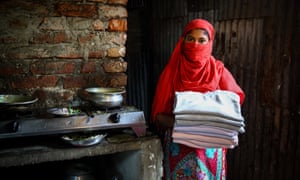
Just four cents from every dollar Australians spend on clothing makes it back to workers enduring “horrific” conditions in garment factories, a new report has found.
The report adds to pressure on Australia’s big clothing retailers, including Kmart, Big W, and Target, to act faster on their ethical sourcing programs.
An analysis of clothing supply chains, conducted by Deloitte for Oxfam Australia, shows just 4% of what Australians spend on clothing goes to the wages of workers in garment factories across the globe. In Bangladesh, it’s as low as 2%.
Bumping up the price of clothing by just 1% would be enough to give garment workers a living wage, the analysis found. That is only 20 cents extra for a $20 t-shirt.
Oxfam chief executive, Helen Szoke, said clothing retailers, which make huge profits, could lift garment workers out of poverty with very little difference to their bottom line.
“I’ve actually been to Dhaka, and we visited some of the facilities. And it just reminded me of being a chicken coup, these little tin sheds with a common corridor often built in really unhealthy circumstances,” Szoke said.
“People pile on top of each other, there are babies … it’s really horrific. And I think the worst thing is that these are people working horrendously long hours, and they’re still trapped in poverty,” she said.
The report gives three harrowing accounts from garment workers in Bangladesh.
The three women face abuse, cramped working conditions, huge production targets, and long overtime.
They earn 35 to 43 cents an hour. The pitiful amounts do not allow garment workers to live with dignity, hygiene or health, the report said.
One worker, Fatima, told the report authors she sleeps on a concrete floor in a small room, which she shares with two other garment workers.
At the factory, she helps to make clothes for Big W and H&M, according to Oxfam.
Her boss skims money from the pay of workers, while she is forced to meet impossible work demands.
“And then they really pressure us; we can’t go to the toilet; we can’t drink water. And it’s because of the targets,” she told Oxfam.
“When I have to work for a long time, my whole body aches, but mainly my knees, my shoulder, my back, my left side. The left side of my back hurts more … because I have to bend to the left for work, that’s why I get more ‘achey’ on the left side.”
Fatima’s mother is sick, and when her wage is low, she is forced to go hungry so she can keep sending money home.







